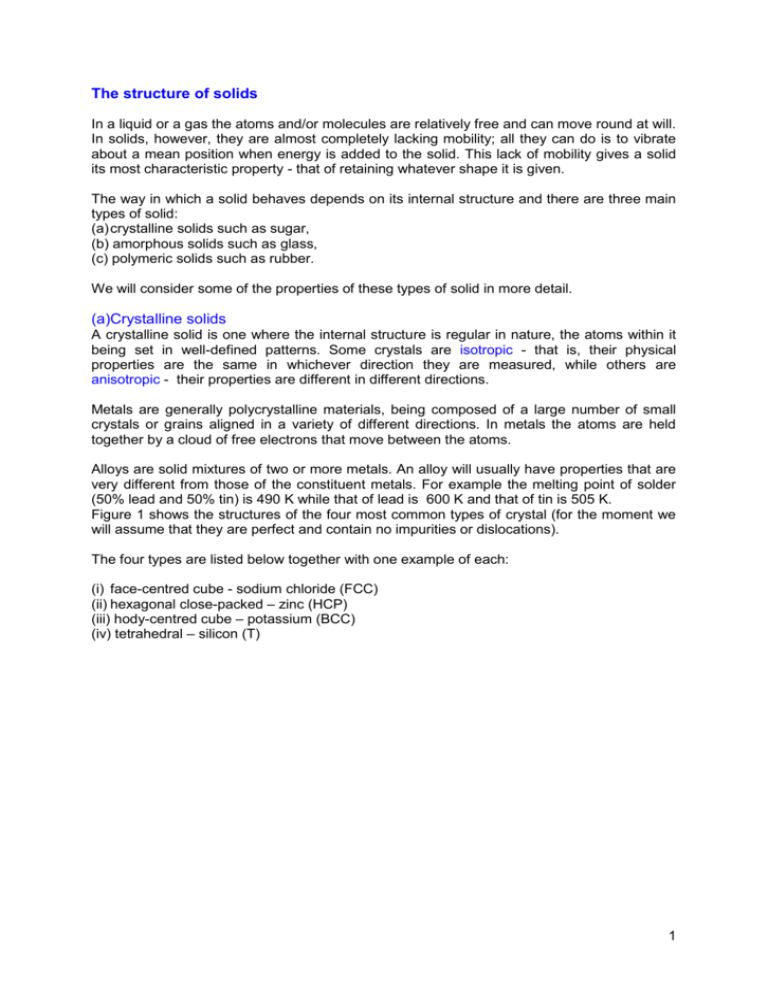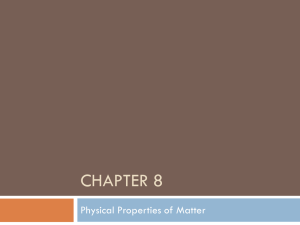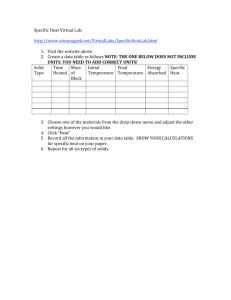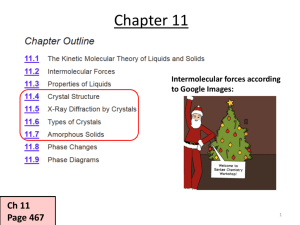Structure of solids
advertisement

The structure of solids In a liquid or a gas the atoms and/or molecules are relatively free and can move round at will. In solids, however, they are almost completely lacking mobility; all they can do is to vibrate about a mean position when energy is added to the solid. This lack of mobility gives a solid its most characteristic property - that of retaining whatever shape it is given. The way in which a solid behaves depends on its internal structure and there are three main types of solid: (a) crystalline solids such as sugar, (b) amorphous solids such as glass, (c) polymeric solids such as rubber. We will consider some of the properties of these types of solid in more detail. (a)Crystalline solids A crystalline solid is one where the internal structure is regular in nature, the atoms within it being set in well-defined patterns. Some crystals are isotropic - that is, their physical properties are the same in whichever direction they are measured, while others are anisotropic - their properties are different in different directions. Metals are generally polycrystalline materials, being composed of a large number of small crystals or grains aligned in a variety of different directions. In metals the atoms are held together by a cloud of free electrons that move between the atoms. Alloys are solid mixtures of two or more metals. An alloy will usually have properties that are very different from those of the constituent metals. For example the melting point of solder (50% lead and 50% tin) is 490 K while that of lead is 600 K and that of tin is 505 K. Figure 1 shows the structures of the four most common types of crystal (for the moment we will assume that they are perfect and contain no impurities or dislocations). The four types are listed below together with one example of each: (i) face-centred cube - sodium chloride (FCC) (ii) hexagonal close-packed – zinc (HCP) (iii) hody-centred cube – potassium (BCC) (iv) tetrahedral – silicon (T) 1 Crystalline solids Face centred cubic Body centred cubic Hexagonal close-packed Tetrahedral Figure 1 Note: The tetrahedral structure is shown in plan view and then as a solid. The individual molecules have been shown different colours to make it easier to distinguish between molecular plains. The characteristics of each structure can be investigated using the techniques of X-ray diffraction. In general, if the solid exhibits a regular structure as shown by the first three crystalline states mentioned the X-ray diffraction pattern will show a series of dots. If it is irregular, however, as in graphite in which the layers are free to slide one over the other, a series of rings will result. (This can also be seen by the electron diffraction through graphite). The face-centred cube and the hexagonal close-packed crystals are the most closely packed structures, and 60 per cent of all metals exist in one or other of these forms. (b) Amorphous solids An amorphous solid exhibits no regular internal structure; glass, plastic and soot are examples. In a way such a solid is like an instantaneous snapshot of a liquid, although one with an enormously great viscosity. An amorphous material has the density of a solid but the internal structure of a liquid. They are considered to be super-cooled liquids in which the molecules are arranged in a random manner similar to that of the liquid state. Amorphous solids are also unlike crystalline solids in that they do not have definite melting points. 2 (c) Polymeric solids In these solids the molecules form long chains which may contain anything between 1000 and 10 000 molecules. Many are natural organic materials such as plant constituents but there are many synthetic polymers, one example being polythene. The precise properties of the polymer depend on just how tightly these chains of molecules are bound together. They may be tangled together in a haphazard way or lie side by side. Figure 2 Any cross-chain linking will enormously increase the strength of the material and the vulcanising of rubber, for example, eventually produces the hard material ebonite: this is the result of cross-chain linking by sulphur atoms. Below a critical temperature polymers behave much like glass (but with a greater degree of ductility) but above it they are more rubber-like. Cooling rubber in liquid nitrogen strikingly illustrates this change of properties. (Note: in the diagram the molecules in the different chains have been given different colours to make them easier to see) (You can find about more about the nature of rubber in the file 'Elasticity of rubber') 3











